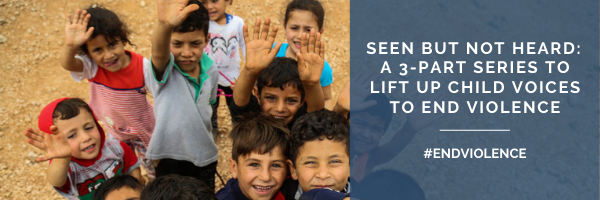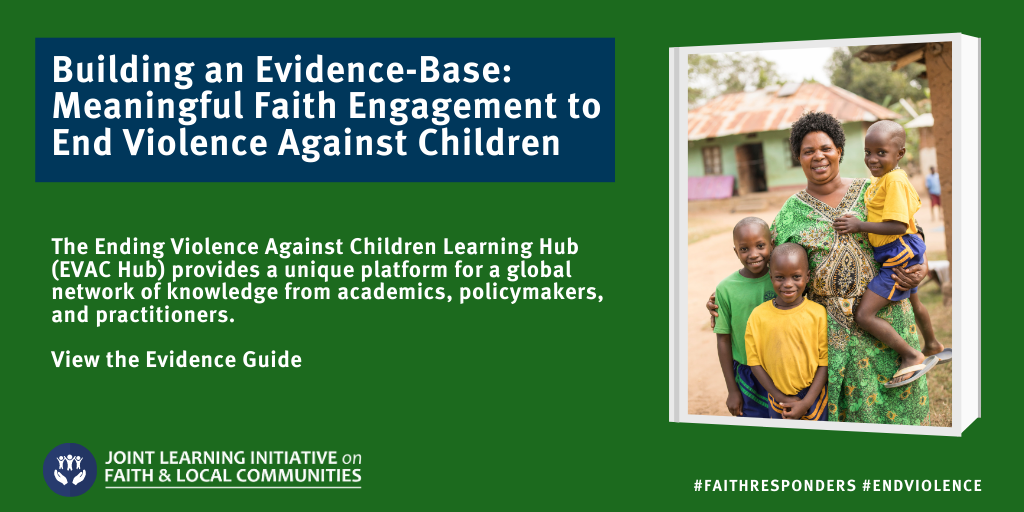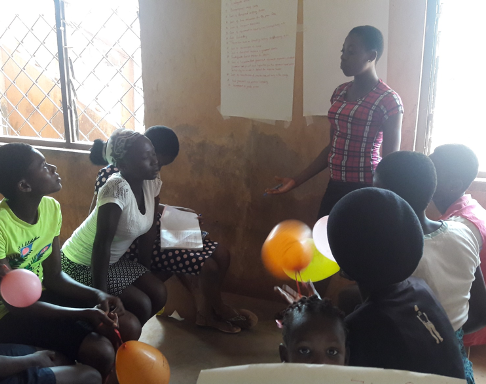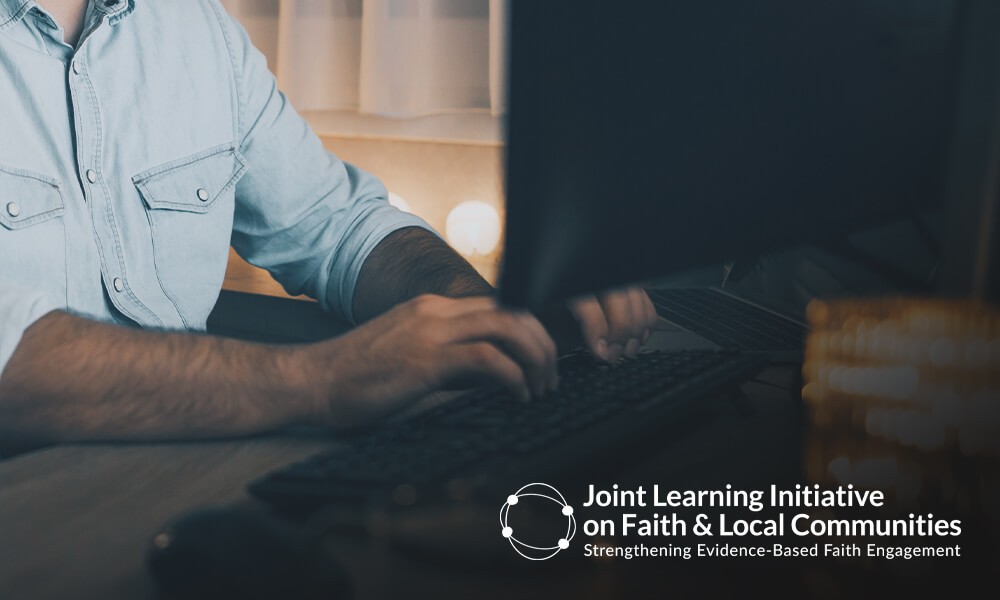
Practical Examples of Child Participation: Event Summary
Child participation is a central pillar in preventing and ending violence against children. Many faith traditions offer critical perspectives on the importance of meaningful child participation. Yet the practical application of child participation in faith communities around the world can be informal or undocumented.
Introducing the JLI’s Evidence Guide on the role of faith communities in ending violence against children, for key learnings, case studies and data from the JLI Scoping Study on Ending Violence Against Children.

The JLI’s Ending Violence Against Children (EVAC) Learning Hub hosted its second webinar in the series Seen But Not Heard: A 3-Part Series to Lift Up Child Voices to End Violence.
Practical Examples of Child Participation brought together a panel of practitioners from Sri Lanka, Pakistan, Nepal, Nigeria and Kenya to share examples of effective child participation in their local faith community contexts. The webinar also hosted a number of interactive breakout sessions, inviting all participants to share their own experiences of child participation, and reflect on the challenges and obstacles involved in this work.
View the webinar slides below or press the download button to the right.
Drawing on the JLI Scoping Study on Ending Violence Against Children, Dr Selina Palm of Stellenbosch University noted that a root cause of violence against children is the belief that children are the silent, obedient property of adults. She asked participants to consider where we envision children in our social structures: at the bottom of a triangular hierarchy, or at the centre of a circle?
How can faith communities drive meaningful child participation in decisions that affect children’s lives? (Check out the Evidence Guide)
Dr Palm offered practical suggestions on how to enable child participation as a means of protection for children, such as:
- Involving children in community and family decisions
- Equipping children to break the silence on their own abuse (or the abuse of others)
- Equipping children as agents of change
- Building child-friendly spaces in religious programmes
- Involving children in spiritual practices
- Promote child voices and intergenerational spaces
“Some faith-based agencies included children in their activities because they saw the power of their influence on adult behaviour. We can learn from children, not just children learning from us” – Dr Selina Palm
Deaconess Juliet Eneh, The Christian Council of Nigeria: Empowering Children to Know Their Rights and Report Abuse
Deaconess Eneh outlined the work done by the Christian Council of Nigeria, which organises workshops for children around Nigeria to enable them to participate in issues concerning their welfare – particularly the issue of violence against children.

Deaconess Eneh also highlighted a project by the Methodist Church Nigeria. Christ Care mentors teenagers on what their rights are, how to protect themselves and how to make reports when in distress. Parallel to this, caregivers were also offered information on how to report cases of violence against children.
One of the primary challenges faced in delivering these projects was the hesitancy of adults, who feared this would lead to children “exposing” their families, churches, or organisations, and the stigma attached to this. To help counter this, the Christian Council of Nigeria organises special sessions for parents, teachers and caregivers to educate them about the need to allow the voice of children to be heard.
“We believe that when children are given the voice to speak, it will bring down violence against them” – Deaconess Juliet Eneh
View resources in the Evidence Guide: How can faith communities work to “break the silence” surrounding violence against children?
Reverend Fred Nyabera introducing Dr Chintamani Yogi and Child Savings Programme in Nepal
Active child participation can often require bold and unconventional programmes. Reverend Nyabera referenced a programme in Nepal whereby children were supported to set up collective savings mechanisms. After a period of time, the children gathered their funds and divided them equitably: a third for themselves, a third for their families and a third for the community.
The nature of this project enabled children to develop essential skills in peacebuilding and peer support. However most crucially, according to Reverend Nyabera, it enabled the children to express themselves about the issues that affected them most in their home, school and community lives. The children chose to use their funds to support projects on child health, child education and provision of food for families in poverty.
“They felt that they were contributing to their society. They were empowered to make the decision” – Reverend Fred Nyabera
Dr Chintamani Yogi spoke of the high status of children within Hindu tradition, where Gods such as Rama, Ganesh and Krishna are worshipped in the form of children. For this reason, Dr Yogi focuses his work on empowering children in situations of poverty and homeless – “children who have difficulty, but they have divinity; children who have problems, but they have potential.”
Viraj Abeysekera: Intergenerational Dialogue and Child Peacebuilding Projects
A common theme in the discussions was the need for child participation to happen at all levels – whether in grassroots actions or in high-level influencing fora. Viraj Abeysekera highlighted World Vision’s multifaceted approach to child participation through two cases studies.
First, World Vision’s global campaign, It Takes a World to End Violence Against Children. One of the activities of this campaign involved bringing faith leaders and children together, to collectively address the issue of violence against children. The intergenerational dialogue enabled children to raise their voices and opinions directly to faith leaders.

Second, a child peacebuilding programme in Sri Lanka, which sought to address inter-communal tension following decades of civil war. This project brought together Christian, Buddhist, Hindu and Muslim faith leaders and children to create interfaith forums. The children began engaging in projects together, such as:
- Cleaning up public spaces (e.g. playgrounds, markets, roads)
- Visiting sick children from other faith backgrounds
- Engaging with each other’s faith celebrations and rituals
Abeysekera noted the ripple effect of these child-led interfaith interactions: it was not just the children who began to build trusting relationships, but the broader communities as a whole began to trust and connect with one another as a result of this programme.
Afshan Jamal: Protecting Children at Risk in Pakistan
Afshan Jamal shared an example of Islamic Relief Pakistan’s work to assist children engaged in street work (particularly those working in hazardous environments) to attend school instead.
The programme exemplified an integrated approach to child participation. Children were consulted and involved at all stages of the project cycle, while families, communities and faith leaders were engaged and educated to support the transition. Removing children from the workplace was challenging, as many families in poverty depended on income. However, through livelihoods interventions, and the faith-teaching interventions of religious leaders during Friday sermons, children were enabled to start attending school.
The programme also strengthened protection mechanisms in the community, and children played a leading role in child safeguarding campaigns, such as through a street theatre project.
Breakout session discussions (click the arrow to see the responses):
The participants divided into breakout sessions, where they were all invited to reflect on the following questions:
- What has worked with regards to child participation to end, prevent, and respond to violence against children and why?
- What are the barriers to child participation?
- What are the possible solutions?
Participants raised a number of issues, such as:
- The importance of building trusting, long-term relationships with children for effective child participation, and the benefits of long-term interventions
- The role of child testimonials, in the form of video clips, in helping adults understand children’s needs (e.g. during training sessions or workshops)
- The role of faith leaders in challenging cultures that silence children
- The challenge of deconstructing the “authority figure” of the adult
- The challenge of conducting effective child participation in churches, versus in schools
- The importance of working with parents and families to overcome the challenges to child participation
- Particular topics that participants felt needed addressing through child participation: sexual health, sexual abuse, household violence, and cyberbullying
- The need to create spaces where children can actively have a voice
- The opportunities and challenges posed by social media during COVID-19 – on the one hand, a platform for children to share their voices and take care of their own wellbeing. However, there are also safeguarding and protection concerns as this is a risk space for children.
- The challenge of defining “child participation” – in some contexts, only light consultation with children is considered sufficient child participation
- The need for intergenerational dialogue, particularly the importance of faith leaders listening to children’s voices
- The need to ensure policies and laws are child-centred
- The mistrust some local faith communities have of “Western”-influenced actors working for child participation. The need for faith leaders and faith teachings to build trust.
Participant Case Studies
Participants were invited to share positive examples of child participation from their own professional and community experiences. Some of these include:
- The Butterfly Longitudinal Study, Cambodia
- World Vision International village-level child fora in Bangladesh
- Sierra Leone Children’s Forum Network
- Campaña de Buentrato (Red VIVA)
- Voz y Fuerza Mexico (Comunidad Judia)
- Arigatou International’s Intergenerational Dialogues
- World Council of Churches – Child-Friendly Churches & Churches Commitment to Children
Lea el resumen en español
View the EVAC Evidence Guide o lea en español
Related Seen But Not Heard events series
- Multi-religious perspectives on child participation (y el resumen en español)
- An intergenerational dialogue on child participation (y el resumen en español)
View the webinar slides below.

